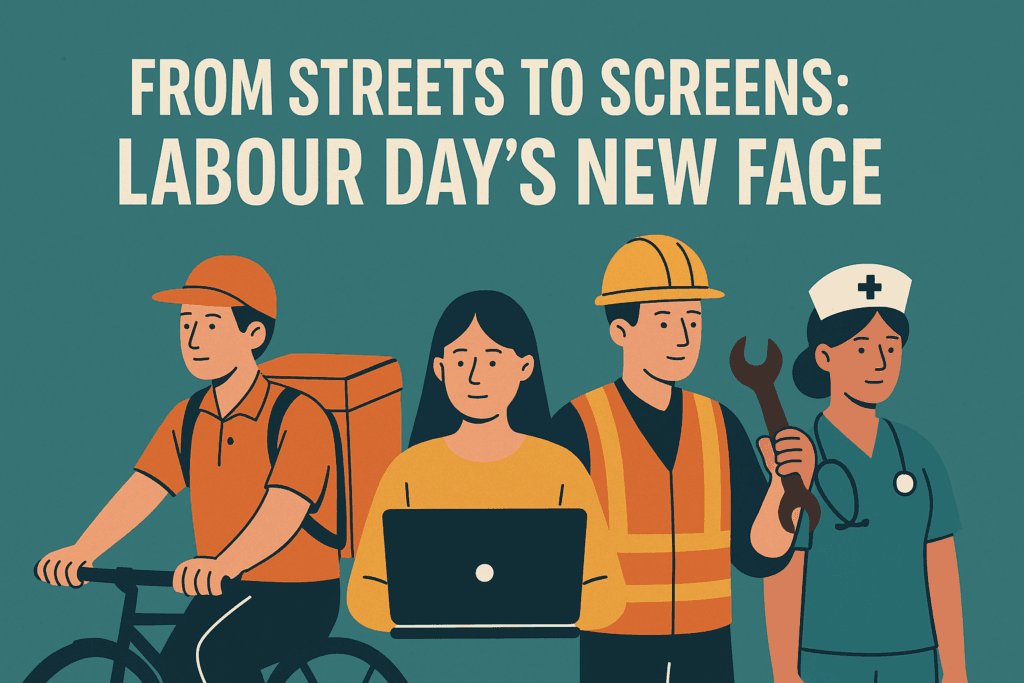
Explore how Labour Day 2025 honors both traditional and digital workers. From streets to screens, discover the new face of modern labour in a tech-driven world.
A New Chapter in Labour History
Labour Day was once synonymous with factory sirens, picket lines, and union rallies. In 2025, the scene has evolved. From construction workers on dusty roads to freelancers behind glowing screens, the definition of “labour” has expanded — and so must our appreciation.
This Labour Day, we spotlight the silent warriors of the digital economy, the undervalued gig workers, and the blue-collar backbones of our cities. Because whether it’s a hand on a wrench or a finger on a trackpad — labour deserves respect.
1. The Rise of the Digital Worker
In the last decade, work has moved from workshops to Wi-Fi. Millions now earn a living through laptops, coding, editing, designing, or managing businesses from home. These digital workers often face:
- No job security
- No health benefits
- 24/7 availability pressure
- Lack of social recognition
Freelancers and remote employees are now a core part of the workforce, but Labour Day celebrations rarely include them. That’s changing in 2025, as labour movements demand equal rights and digital labour laws.
2. Gig Economy: The Unseen Workforce
The gig economy fuels modern life. Your food, ride, and groceries arrive in minutes — thanks to riders, drivers, and warehouse pickers. But behind this convenience are low wages, unstable hours, and zero safety nets.
In Pakistan alone, over one million people work in gig-based jobs, yet their legal protections remain minimal. Labour Day 2025 shines a light on their fight for basic dignity, insurance, and stable incomes.
3. Traditional Labour Still Matters
While digital jobs rise, traditional labour is far from obsolete. Construction workers, electricians, cleaners, and factory staff still form the backbone of society. In Pakistan, many earn below Rs 25,000/month while working in harsh conditions.
Labour Day is their day. But even in 2025, many of them:
- Lack access to safety gear
- Face wage theft
- Are denied medical coverage
Unions and rights groups are demanding minimum wage hikes, healthcare, and enforcement of labour laws across all provinces.
4. Women in Labour: The Silent Struggle
Women contribute immensely to the economy — both inside and outside homes. Yet their labour often goes unpaid, unregulated, and unrecognized.
Home-based garment workers in Karachi, cotton-pickers in Punjab, or e-commerce moms managing shops on Instagram — their work is real labour.
In 2025, platforms like Women Workers Alliance are pushing for:
- Paid maternity leave
- Equal pay
- Protection against harassment
5. The Way Forward: Digital + Dignity
Labour Day 2025 must evolve from a ceremonial parade to a platform for progress. This year’s global focus is on inclusive recognition — from streets to screens, every worker matters.
Whether you’re tipping a delivery rider or supporting fair-trade creators online, your everyday choices help define the future of labour.
Conclusion: Rethink. Respect. Rise.
From factory floors to virtual offices, Labour Day now carries new meaning. It’s no longer about where or how you work — but whether your work is respected and protected.
This Labour Day, don’t just take a break — take a stand. From sweat-stained shirts to screen-lit eyes, every worker writes the story of progress.

